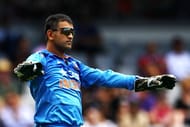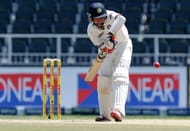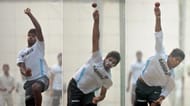An ODI series between a team ranked No.8 and the other positioned comfortably at the numero-uno spot in the ICC rankings could well be presumed to be a one-sided affair, and the ongoing India-New Zealand ODI series has been no exception. Though, in this case the laurels have actually gone to the team ranked lower. Even after being on the receiving end of the mauling in the recently (a term used quite often in the present cricket calendar) concluded ODI series against South Africa, the ‘Men in Blue’ were deemed as the favorites ahead of the ODI series against the Kiwis.
But, owing to a strong performance by the Black Caps and some below par showings in probably all the aspects of the game by Team India, the Kiwis have registered a comprehensive series win. On one hand, it was a shot in the arm for the Black Caps who sealed their first series win at home in five years against a major Test playing nation, whereas on the other, it was a time for introspection for the ‘Rockstars’. But the defeat could well be a blessing in disguise for the Indian team.
As far as ODI cricket goes, Team India had a wonderful last year marked with some memorable victories. However, there were still some seriously worrying aspects of the game that they had refused to fix, which usually happens when results come your way. Those aspects have come to light now. A defeat can never be a good thing, but it’s timing can occasionally be not so bad.
The defeats on these tours of New Zealand and South Africa have quite blatantly exposed Team India’s weaknesses, but at the same time with ICC’s flagship tournament still almost a year away, it has also given the team a golden opportunity to carefully dissect and eliminate the following of their frailties before the big event.
The Cheteshwar Pujara conundrum
The current Indian batting line-up with the likes of Shikhar Dhawan, Rohit Sharma, Virat Kohli and Suresh Raina has time and again proved that flamboyance and scoring quick runs have never been their problems, which was amply clear against the Aussies in the One-day series at home last October. The real predicament lies when this same line-up has to apply themselves in tough conditions against quality pace bowling. And only two of the current Indian batsmen i.e. Virat Kohli and Mahendra Singh Dhoni have been able to tackle both these challenges successfully. To further worsen the matter, one of these two doesn’t even bat in the top-order.
So, for the current Indian batting line-up to be successful against quality attacks in alien conditions, the need of the hour is solidity and not flashiness; this is where Pujara comes in. Awarded the ‘ICC Emerging Cricketer of the Year 2013’, Pujara is someone who not only has a technique as tight as the security at the White House but also the temperament required to battle it out in tough conditions.
A test average of 66.25 with six 100s is a testimony to both his temperament as well as technique. And if there were any doubts about his ability to score outside the sub-continent, he brushed all those away by scoring 280 runs at an average of 70 against probably the toughest attack that a present day batsman can face.
Despite all these successes, the biggest argument against the Saurashtra stalwart is that he is too cautious to have a significant impact in limited overs cricket. The fundamental flaw in this argument has been exposed time and again by the success of the so called Test specialists in the One-day arena such as Rahul Dravid, Jacques Kallis and now even Kane Williamson.
Moreover, with new balls from both ends, the world cup being scheduled on the naturally bouncy tracks down-under and the presence of probably one too many aggressive batsmen in the line-up, it’s this caution and solidity of Pujara that is going to serve India the best. He can quite easily be slotted in at number four, which would allow Dhawan, Rohit and even Virat to play freely and exploit the fielding restrictions with the knowledge of having someone as solid as Pujara to follow.
The other possible option is to bring Pujara as an opener as he has been quite successful in the limited opportunities that he has got at that position in Tests, and possibly push Rohit back down to his original middle order position at number four.
But more importantly, with an average of over 54 in 68 List A innings, it is imperative that with just two failures in One-dayers at the international level, the Saurashtra run-machine is not discarded as a limited overs choice.
The lower middle muddle
Apart from the failures of the two openers to give good starts, it was also the failures of Rahane and Raina that resulted in the several failed chases on the tours of New Zealand and South Africa. Not to forget, Yuvraj Singh was dropped from the squad for exactly the same reason.
The problems of Raina and Yuvraj stretch back to the home series against Australia in conditions where almost everyone with a willow had a time of their batting lives. Assuming Pujara becomes a part of the eleven, the top four looks settled with Rohit, Dhawan, Kohli and Pujara. The problem for India is to find an ideal no.5 or 6, subject to where Dhoni bats.
Though Ravichandran Ashwin batted at no.6 in the 4th ODI against the Black Caps, it seems highly unlikely that it would be a long term solution. So, presently the options available are probably skewed towards Raina, Ambati Rayudu, Yuvraj, and probably Dinesh Karthik with an outside chance. Of the 5 available, Rayudu and Karthik look the more solid of the choices when compared to the two southpaws.
But with four out of the top five being right-handers, the presence of Yuvi and Raina could lend a proper balance in the line-up, which can come in pretty handy against an attack with a variety. Still, the biggest factor in favour of the left handers is the fact that both of them provide the team with an extra bowling option. However, on the basis of runs, which should be the primary factor distinguishing the contenders for the middle order slot, Yuvraj and Raina fall slightly behind on current form.
For the time being, the decision for the no.5/6 should be reserved and only be made after monitoring the performances of the mentioned contenders in the upcoming tournaments namely the Asia Cup, ICC World T20, Vijay Hazare trophy, and of course, the IPL.
The Bowling (If we can still call it that)
There is nothing that scares, angers and frustrates an Indian cricket fan more than the dreaded ‘B’ word. Indian bowling has been the most common subject in the cricketing circles recently, and to be honest, the flak is justified.
Barring Ravindra Jadeja, none of the Indian bowlers have been able to produce respectable performances consistently. And for the kind of batting that India has, coupled with the new rule changes, anything below 300 can be categorized as ‘respectable’.
But, right from the start of the season against Australia, the Indian bowlers have consistently allowed the opposition to amass scores of over 300. Even on pitches that had something in it for the seamers, such as the ones at Johannesburg, Centurion or even Napier, the seamers failed to impress. As the Indian skipper himself admitted in the press conference after the 4th ODI against the Black Caps, it’s not just the rule changes, but some poor bowling by the Indian seamers that has led to the terrible results.
Though Ashwin has been unable to have a major impact in recent times, he has still managed an average economy rate of 5.67 over the ODI series against Australia, South Africa and New Zealand. When compared to the average economy rates during the same period of the leading fast bowlers Ishant Sharma (6.77), Mohammed Shami(6.90) and Bhuvneshwar Kumar(6.09), Ashwin’s figures look even better.
Moreover, both the Indian spinners – Jadeja as well as Ashwin – have often contributed with some useful knocks down the order. Also, when assisted with helpful conditions such as the ones in the Champions trophy final or in the fourth ODI in New Zealand, the spinners have looked really threatening. Thus, the duo of Jadeja and Ashwin backed with the reserves outside the squad such as Amit Mishra and Harbhajan Singh give the spin department a formidable look for the World Cup in 2015.
The real problem and a complex one too is with the seam bowling options. Ishant, Vinay Kumar, Irfan Pathan, Umesh Yadav, Jaidev Unadkat and a few more have been tried with not much success. Even Bhuvneshwar and Shami have not been as effective as one would want them to; nevertheless, they still are clearly the two best fast bowling options available in the country.
Umesh Yadav and Varun Aaron have decent pace but fail to complement that with enough control. But, with the limited alternatives in hand, one of the two definitely deserves a look into the One-day squad. Assuming that India would ideally want five seamers in the world cup squad, the rest two places are up for grabs but worryingly with no prime contenders.
Ishant, Vinay, R.P Singh, Unadkat have all flattered to deceive. Even Zaheer Khan doesn’t look like a viable option presently because of his fitness and fielding or the lack of those, and his exploits would be further restricted with the new playing condition of two new balls, which has nullified any scope of the main weapon in Zak’s armoury – reverse swing.
If consistently horrendous performances and no truly exciting prospects don’t warrant a change in strategy, then probably nothing does. The change here refers to bringing in seamers who are not just out and out seamers but can also contribute significantly in other disciplines. With the performance bar in recent times set so low by the so called ‘specialist’ Indian seamers, it is very hard to believe that the prospective bowling all-rounders can possibly yield worse results.
The best option available presently to fulfill the role of a seam bowling all-rounder is Rishi Dhawan, who has not only been amongst the highest wicket takers in the domestic circuit in the past couple of seasons but also has a decent batting record with first class and List A averages of about 40 and 24 respectively. Apart from him, Irfan Pathan (subject to his fitness), Stuart Binny, Rajat Bhatia, or even the Bengal veteran Laxmi Shukla can also be tried for that role. But keeping in mind the tracks of Australia and New Zealand, the choice should probably be skewed primarily between Irfan and Rishi Dhawan.
None of the above mentioned measures can be categorized as knee-jerk reactions, and a team which has won 6 out of 7 ODI series just a year ago probably doesn’t even need a major overhaul. But with the horrendous performances in overseas conditions of late and the world cup scheduled just a year away in similar conditions, the above mentioned tweaks are definitely worth going for.
Follow IPL Auction 2025 Live Updates, News & Biddings at Sportskeeda. Get the fastest updates on Mega-Auction and cricket news



